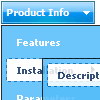Recent Questions
Q: I am afraid I am still having difficulties.
Key issue is fine, no problems there. However, I cannot seem to make this NOT showing me a window open example when the page opens. I just want to have popups upon click. What I want is to be able to create links, within the same page, that will popup windows of different content and size, all upon click (not upon page loading.
What am I doing wrong here?
In the site I have the following:
1. A www.domain.gr/deluxe-popup-window.files folder
2. A http://www.domain.gr/deluxe-popup-window.js script
3. and my test page creating the popups
So, in my sample page:
1. I do NOT want to have the 1st popup which loads automatically as the page opens
2. I want to have the 2 samples shown there, Sample 2 and Sample 3.
3. These 2 samples must show windows of different width and height.
Please help me here.
Looking forward to your answer.
A: Delete openAfter= text from the deluxePopupWindow.attachToEvent()function in the following file:
http://www.domain.gr/deluxe-popup-window.js
In that case popup window won't show till you click on the link.
deluxePopupWindow.attachToEvent(win,',,,,,')Q: I'm trying to get the dhtml tab menu aligned to the right. Can you make a suggestion on how I can do this?
A: Try to install your tabs into the table with right alignment, for example:
<table width='100%'>
<tr>
<td align="right">
<script type="text/javascript" src="test_files/tdata.js"></script>
</td>
</tr>
</table >
Q: Would it work to put the javascript command in the dhtml context menu Link entry so that when a person clicks on the menu item, he navigates to the webpage specified in the onclick?
A: Actually you can use your own Javascript code instead standard links and html code inside item text. For example:
var tmenuItems = [
["text", "javascript:window.location.href=myvalue"]
];
or
var tmenuitems = [
["Table of Contents
", ""]
];
Q: I really like how this works and I think it will wind up working for us, but I have a question. On the xp style dynamic tree menu, is there a way when you click one of the 'headers' that will open up other choices for example on your http://www.deluxe-tree.com/data-samples/tree-menuxp3.html tree. When youclick either the deluxe tree:xp style or the samples gallery or the samples gallery2 section, can you make it so it opens a page in another frame? The way it is now you it wont open a page until you click on the 'samples block 1' or below.
A: Actually you cannot use links for the top items in the XP Style.
But theoretically you can use links for the top items. You can write
["<a href='index.html' class='home' target="frame">Home</a>","", "", "", "", "Return to Index page", "", "0", "", ],
["<a href='http://www.domain.uk' class='home' target="frame">About Us</a>","", "", "", "", "", "", "0", "", ],
["|Introduction","http://www.domain.uk/introduction.htm", "", "", "", "", "", "", "", ],










